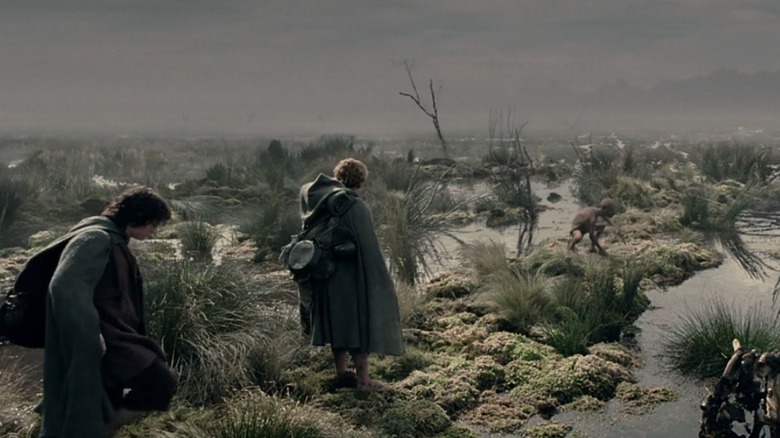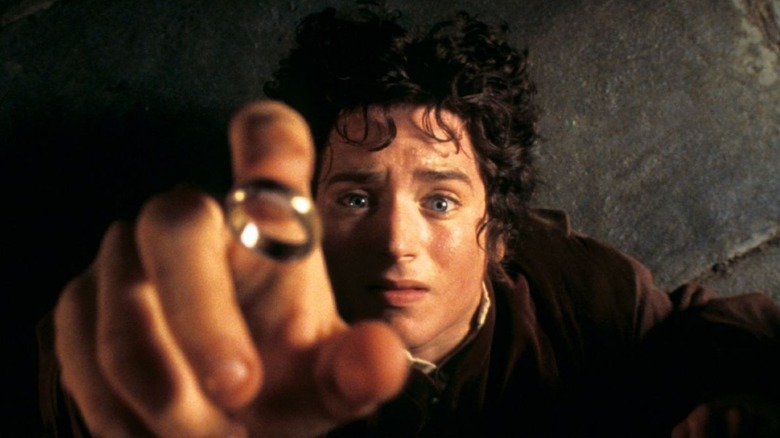This Lord Of The Rings: The Two Towers Scene Was Actually Filmed In A Parking Lot
In his adaptation of "The Lord Of The Rings," filmmaker Peter Jackson used several real-life locations to bring Middle-earth to life. From Mordor to Hobbiton, and the entrance to the realm of Lothlórien, Jackson and the cast filmed at over 150 locations in New Zealand to depict the unending beauty of Middle-earth. That being said, not every location consisted of vast, rugged landscapes and ethereal architecture — some scenes were also filmed in parking lots.
In the sequel titled "The Lord of the Rings: The Two Towers," Gollum (Andy Serkis) leads Frodo Baggins (Elijah Wood) and Samwise Gamgee (Sean Astin) on the quest to destroy the One Ring. At one point, the three arrive at The Dead Marshes — a swampland teeming with ghostly faces of dead Elven, Mannish, and Orc warriors from past wars. In the paragraph where Tolkien goes over his description of the marshes, the author writes that the wasteland caused by the war was "dreary and wearisome."
While the scene in the adaptation effectively represented Tolkien's vision, Peter Jackson and his star cast didn't have to film the scene in a natural marshland — they found an empty parking lot to house the set instead.
Where The Dead Marshes were filmed
Remember when Frodo Baggins fell into The Dead Marshes? And Gollum saved the day? That scene was entirely filmed in a parking lot!
In the movie, The Dead Marshes are shown as an endless channel of small ponds with jets of fire. To recreate the scene, director Peter Jackson and cinematographer Andrew Lesnie considered filming in the extensive marshes on New Zealand's South Island. But they soon discovered that filming in a marshland wasn't realistic because it was impossible to negotiate the route on foot. So for reasons adhering to the safety of the cast and crew, the production team shifted their location to a water-filled parking lot instead. On a "Lord of the Rings" featurette, franchise star Elijah Wood shared:
"The Dead Marshes were filmed in a parking lot and a variety of parking lots – first and foremost on this wet set that was initially used for outside the Gates of Moria and was switched over and made into the Dead Marshes," shared Elijah Wood.
The team created their marshes — they built multiple water-ready facilities in Wellington studios and other locations. An exterior set of a flooded car park was made from scratch, and the art department was tasked with transporting landmasses of moss and vegetation from natural marshlands.
Real Moss And Vegetation Was Added To The Set
Cinematographer Andrew Lesnie also detailed how the team designed the Dead Marshes in "The Lord of the Rings: The Two Towers" special features:
"Apart from one aerial shot of the real marshes, the rest of the Dead Marshes was created on three 'wet sets', one indoors and two outside," Lesnie explained. "The biggest exterior set was a flooded carpark spanning thousands of square meters and skillfully dressed by the art department with structural landmasses and moss and vegetation transported from the real marshlands."
"The set was strategically positioned facing north to guarantee maximum backlight over the course of each shooting day, and massive sky backdrops or bluescreens were backed by shipping containers and scaffold ran along the north, east and western edges of the set."
While the scene was majorly filmed on the bigger wet set, the team decided to create a smaller outdoor setting in the studio's car park so they could pay greater attention to the dead at the surface of the dead marshes.
"The smaller outdoor set was created in the studio carpark to offer more control for WETA Workshop's 'spectral corpses' [the "dead" who give the marshes their name]. Night and pre-dawn scenes were filmed on the interior set in order to avoid subjecting the actors and crew to freezing night temperatures."
The Dead Marshes have a significant history in Tolkien's universe — they were part of the ancient battlefield of the Battle of Dagorlad during the War of the Last Alliance. As time went on, the battlefield turned into a marshland that swallowed the dead, although apparitions of the bodies remained floating on the surface. As Frodo and Sam walk through the Marshes, they can feel the echo of what once was and the consequences of war, despite the land being centuries removed from it.

